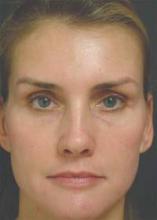Pre-resurfacing goals include controlling acne and rosacea, testing compliance, enhancing wound healing, and controlling pigment production. When all of these issues are addressed prior to resurfacing, results are enhanced. “Always do a skin conditioning treatment, as this makes results more dramatic,” said Dr. Obagi. “I usually do a pre-resurfacing regimen for 6 weeks on a lighter-skinned patient; on a patient with darker skin I continue the regimen for about 12 weeks before I feel I can safely treat them,” she said.
Resurfacing treatments must be tailored to differing levels of the skin for different conditions, Dr. Obagi noted. Sun damage resides very superficially in the epidermis, wrinkles and scars can reside superficially or deeper, and acne and rosacea involve deeper layers of the skin. Some treatments will not go deep enough in the skin to address certain problems, so it is crucial to address treatment depths to where the problem actually resides. “Although new lasers are constantly introduced, one thing that has remained stable is skin cells; we know we can only target certain ones,” she added.
Cellular targets for skin health restoration in the keratinocytes involve normalizing turnover and improving atypia; in the melanocytes, the targets involve decreasing pigment production and enhancing melanin distribution. Deeper in the dermis, cellular targets for skin health in the fibroblasts include increasing collagen, elastin and glycosaminoglycans (GAGs). “We want to take these cells and really stimulate and control them at every level, so we can make patients heal the way we want them to post procedurally,” explained Dr. Obagi.
For best results, postresurfacing goals should involve resuming control of acne and rosacea, monitoring for complications such as infections, and enhancing wound healing through such modalities as steroids, antibiotics, or low-level lasers when appropriate. “However, the most crucial postresurfacing goal is controlling pigmentation. Don’t wait for hyperpigmentation to occur; it is much harder to treat than it is to prevent,” Dr. Obagi emphasized.
Establishing a proper skin care regimen prior to a procedure is vital in combating aging, and will in turn produce better and longer-lasting procedure results with fewer complications, said Dr. Obagi. Further, communicating with patients and involving them in their own skin care establishes trust and confidence. These patients will be happier with their surgical results, will report for regular follow-ups, and will serve as sources of referral. “If you deliver results before you even get to the procedure, the patient will trust you implicitly,” Dr. Obagi said.
Dr. Obagi reported serving on the scientific advisory board for Valeant Pharmaceuticals.


